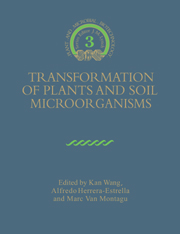Series Preface
Published online by Cambridge University Press: 04 August 2010
Summary
The primary concept of this series of books is to produce volumes covering the integration of plant and microbial biology in modern biotechnological science. Illustrations abound, for example the development of plant molecular biology has been heavily dependent on the use of microbial vectors, and the growth of plant cells in culture has drawn largely on microbial fermentation technology. In both of these cases the understanding of microbial processes is now benefiting from the enormous investments made in plant biotechnology. It is interesting to note that many educational institutions are also beginning to see things this way and integrating departments previously separated by artificial boundaries.
Having set the scope of the series, the next objective was to produce books on subjects that had not already been covered in the existing literature and, it was hoped, to set some new trends.
One of the most commonly used techniques to genetically engineer both plants and microorganisms is transformation. However, it seemed to me that, whereas transformation was of course covered in all molecular biology textbooks, a substantive research monograph that would cover this exciting and expanding field was not available.
The Genetics Laboratory at the University of Gent, under the direction of Marc Van Montagu, has been an earlier ‘player’ and is now a world leader in transformation. Particularly, their involvement in the characterization of the Ti (tumor inducing) plasmid from a soil bacterium (Agrobacterium tumefaciens) and its use in the transformation of plants set one of the first scenes for plant molecular biology to emerge. Marc Van Montagu was, therefore, an obvious choice as a volume editor. One of the great strengths of the Gent Laboratory has been its international flavor.
- Type
- Chapter
- Information
- Transformation of Plants and Soil Microorganisms , pp. xiii - xivPublisher: Cambridge University PressPrint publication year: 1995



